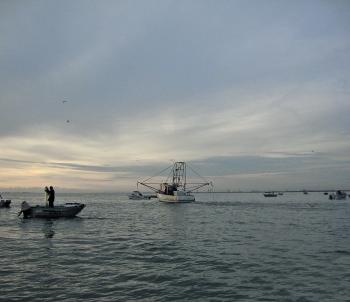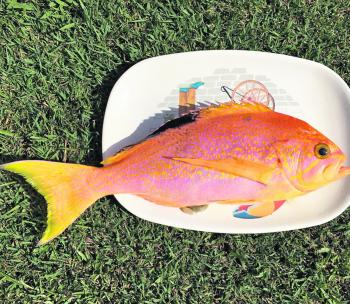Water safety must be taken more seriously. Recently a trawler had his nets in the water and steamed from Woody Point towards Nudgee over a distance of several kilometres straight at a cluster of about 50 recreational fishers casting for banana prawns. He trawled straight through the edge of the group and then turned at right angles and forced his way through them. These boats had been sitting as a group for at least half an hour. One of the boats barely got his motor started in time to move out of the way.
Surprisingly, in spite of this dangerous, aggressive and stupid behaviour we struggled to get authorities to act. Fisheries Queensland advised us to go to the water police or MSQ, the water police advised us to go to Fisheries and MSQ finally agreed to let us lodge a case and they would consider whether to act or not. Apparently, until someone actually gets hurt, the water police have a policy to file a report to MSQ only but not take any further action. We had photographic evidence and a police officer in one of the boats as a witness but still little action.
Over the years rumours suggest that commercial fishing vessels have absolute right of way. After a thorough look at the legislation this is in fact not true. Any vessel underway must give way to a vessel fishing or to a trawler with its nets deployed. In the current case even though the trawler had its nets deployed and was prawning, the other vessels were not underway and visibility was clear. This means that the trawler who was under power should have avoided the recreational vessels fishing who were not under power at the time. This is International Maritime Law.
The trawler in question has demonstrated dangerous behaviour on more than one occasion and these actions threaten the safety of other boaties. Take care for your safety, take photos of dangerous activities if it is safe to do so and report the incident.
It has now become very difficult for community recreational fishing groups to remain apolitical since commercial netters have now placed one of their own into local government. In March the LNP clearly demonstrated their position with regards to commercial and recreational fishing, especially inshore gill netting. The LNP party machinery were out in full force during the local government elections in Moreton Bay. Their candidate in Division 1 who didn’t openly declare their support on her advertising was showcased in the preceding weeks by LNP powerbroker Lisa France. Lisa France has previously made her lack of support for recreational fishers very clear. The LNP even brought party members from Hervey Bay to the shores of Bribie Island to help campaign including handing out her how to vote materials. Mrs Savige was not even prepared to acknowledge her commercial fishing background until we provided the number of the commercial fishing licenses that has her name on it.
Sadly, local recreational fishers now have a member of a prominent gillnetting family as their local representative. It was not possible to match the financial might of the LNP.
Member of the Commonwealth Productivity Commission into Australian Fisheries were recently in Queensland for a series of meetings with all sectors of the fishing community –recreational, commercial, charter, marketing and indigenous. The only facet outside their reach is freshwater fishing. The committee had many items already identified as requiring further information with respect to recreational fishing.
Are controls such as licences, bag limits and size limits effective? Is there scope to reduce the burden (time or monetary costs) of fishing rules on recreational fishers while achieving the same regulatory objectives? How well is recreational fishing recognised in current fisheries management and regulatory arrangements (including in relation to access rights)? How does the regulation of commercial fisheries affect recreational fishers? What are the main sources of tension between recreational fishers and other fishery users? What, if any, tensions exist between the controls on recreational fishing across jurisdictions and fisheries? Given the services provided by state and territory governments to support recreational fishing, do recreational fishers get good value from licence fees?
You can still provide feedback to these questions at www.pc.gov.au/inquiries/current/fisheries-aquaculture/recreational-fishers-have-your-say.
Just remember that not all recreational fishing license programs are called that. Our recreational use fee has just gone up to $20 per recreational vessel. So, if you are like us and have a tinny and a glass boat you pay $40. In NSW a recreational fishing license is only $35 per year. Our $40 returns more to Fisheries each year than commercial fishing licences and the money we pay is handed over free and clear. Yet in NSW and other states there are committees that partner with Fisheries in determining how that money is spent. Most also run small grants programs for recreational fishing, fund their peak body and invest in developing their recreational fishery. I certainly wouldn’t want us to pay more and receive less than we currently do.
We need to pose the question to the review as to why other states can manage this but Queensland can’t seem to.
Facts
What fish is that?
This fish was caught out off Tempest by Gary Kraut who was snapper fishing with Jeff Ahchay in April. Answer on page XXXXXX
Answer
Long finned perch (Caprodon longimanis). It’s called pink maomao in New Zealand and is apparently good eating. Thanks again to Dr Julian Pepperell for his identification.
Identification (Australian Museum Data)
| Standard Common Name | Longfin Perch |
|---|---|
| Alternative Name/s | Pink Maomao |
| Identification | The Longfin Perch has a long-based dorsal fin, an emarginate caudal fin . Its pointed pectoral fins are longer than the head. Females are pink to red. Males are pinkish with yellow spots and a large dark blotch on the dorsal fin. |
| Size range | Up to 58cm in length. |
| Distribution | The longfin perch occurs in Australia, New Zealand and the Kermadec Islands. In Australia it is known from southern Queensland to southern New South Wales. |
| Source | http://www.ala.org.au/ |

Here the trawler ploughs through the active fishing grounds with no consideration for the safety of others. The little boat in the front barely got out of the way in time.

What fish is this?




